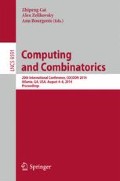Abstract
In this paper, we present a diffusion model developed by enriching the generalized random graph (a.k.a. configuration model), motivated by the phenomenon of viral marketing in social networks. The main results on this model are rigorously proved in [3], and in this paper we focus on applications. Specifically, we consider random networks having Poisson and Power Law degree distributions where the nodes are assumed to have varying attitudes towards influence propagation, which we encode in the model by their transmitter degrees. We link a condition involving total degree and transmitter degree distributions to the effectiveness of a marketing campaign. This suggests a novel approach to decision-making by a firm in the context of viral marketing which does not depend on the detailed information of the network structure.
Access this chapter
Tax calculation will be finalised at checkout
Purchases are for personal use only
Preview
Unable to display preview. Download preview PDF.
References
Bailey, N.: The Mathematical Theory of Infectious Diseases. Books on cognate subjects. Griffin (1975)
Banerjee, A.V.: A simple model of herd behavior. The Quarterly Journal of Economics 107(3), 797–817 (1992)
Błaszczyszyn, B., Gaurav, K.: Viral marketing on configuration model. arxiv 1309.5779 (2013) (submitted)
Cheng, J., Adamic, L., Dow, P.A., Kleinberg, J.M., Leskovec, J.: Can cascades be predicted? In: Proc. of WWW, pp. 925–936 (2014)
Janson, S., Luczak, M.J.: A new approach to the giant component problem. Random Structures and Algorithms 34(2), 197–216 (2008)
Kempe, D., Kleinberg, J., Tardos, E.: Maximizing the spread of influence through a social network. In: Proc. of ACM SIGKDD, KDD 2003, pp. 137–146. ACM, New York (2003)
Moore, C., Newman, M.E.J.: Epidemics and percolation in small-world networks 61, 5678–5682 (May 2000)
Van Der Hofstad, R.: Random graphs and complex networks (2009), http://www.win.tue.nl/rhofstad/NotesRGCN.pdf
Yagan, O., Qian, D., Zhang, J., Cochran, D.: Conjoining speeds up information diffusion in overlaying social-physical networks. IEEE JSAC 31(6), 1038–1048 (2013)
Author information
Authors and Affiliations
Editor information
Editors and Affiliations
Rights and permissions
Copyright information
© 2014 Springer International Publishing Switzerland
About this paper
Cite this paper
Gaurav, K., Błaszczyszyn, B., Keeler, P.H. (2014). Pioneers of Influence Propagation in Social Networks. In: Cai, Z., Zelikovsky, A., Bourgeois, A. (eds) Computing and Combinatorics. COCOON 2014. Lecture Notes in Computer Science, vol 8591. Springer, Cham. https://doi.org/10.1007/978-3-319-08783-2_54
Download citation
DOI: https://doi.org/10.1007/978-3-319-08783-2_54
Publisher Name: Springer, Cham
Print ISBN: 978-3-319-08782-5
Online ISBN: 978-3-319-08783-2
eBook Packages: Computer ScienceComputer Science (R0)

